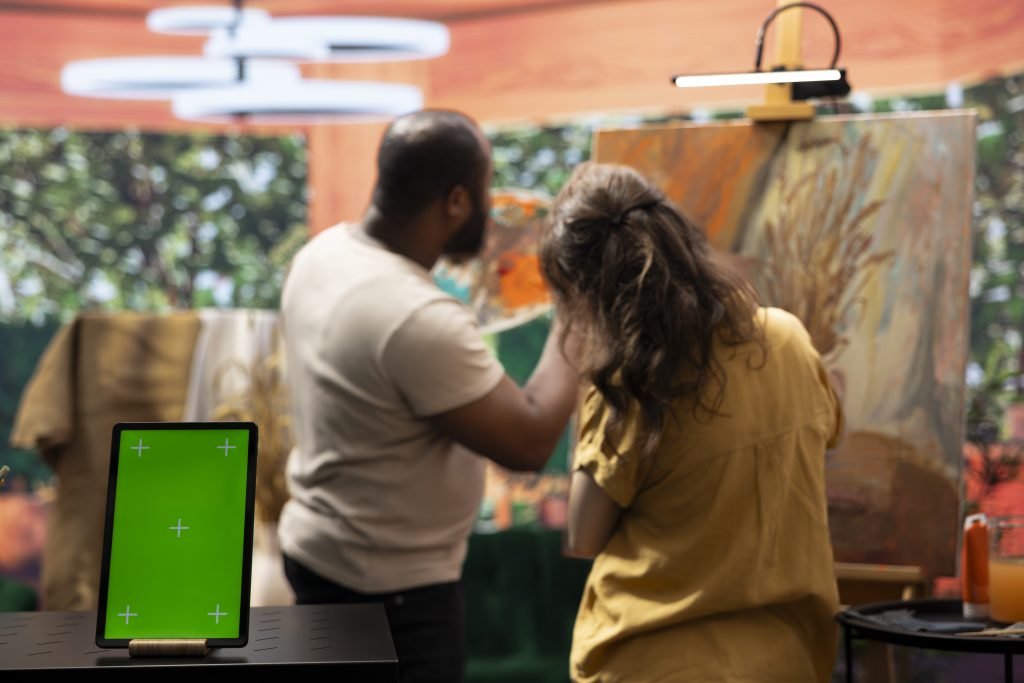Color Prediction Game Design: Behind the Scenes of UX Flow and Triggers
Color prediction games may seem simple, but behind their vibrant colors and fast-paced gameplay lies a carefully crafted UX system powered by behavioral psychology. This article breaks down how design elements—from countdowns to micro-interactions—are engineered to maximize engagement while raising important ethical concerns.

Skilled painters working on an artistic creation next to chroma key screen, using watercolor paint and brush kit to create a masterpiece. Two diverse artists enjoying their creative hobby.
Color prediction games have become a notable fixture in the digital gaming and betting ecosystem. Their allure lies in their simplicity: choose a color, place a bet, and wait for the outcome. Yet, the apparent ease masks a sophisticated design architecture working behind the scenes. These games are carefully engineered using advanced user experience (UX) principles and behavioral psychology. From micro-interactions to visual flow, every element is crafted to guide users through a loop of engagement, anticipation, and action.
This article takes a look behind the curtain, uncovering the UX flow and psychological triggers that shape how players interact with color prediction platforms.
The Entry Point: Welcome Screens and Emotional Hooks
The UX journey begins the moment a player lands on the home page or app. Most games feature minimal onboarding, ensuring users can start quickly without the friction of lengthy tutorials. However, beneath the clean interface are subtle cues designed to establish trust and spark curiosity. Bright, vibrant color schemes immediately draw attention, often symbolizing energy, luck, or urgency.
The welcome experience typically includes a combination of promotional banners, free trials, or introductory bonuses. These elements serve as emotional anchors, giving players a sense of exclusivity and immediate gratification. This first touchpoint sets the tone for the player’s behavior throughout their engagement with the platform.
Navigating the Core Interface
Once inside, the user is presented with the core loop of the game: color selection, betting, countdown, and result. The interface is designed to be intuitive, allowing players to interact without needing to read instructions. However, what appears to be simplicity is a calculated design choice that minimizes decision friction.
A typical layout might feature three or more color tiles, animated buttons, and a dynamic countdown timer. The colors are placed equidistant from each other to imply fairness, yet may differ in opacity or emphasis based on previous outcomes, subtly drawing the user’s eye. The countdown is usually designed with pulsing motion or ticking sounds to heighten urgency. As time winds down, some platforms intentionally speed up animation cycles to create a mild sense of panic—this increases impulsive bets and reduces second-guessing.
Flow State and Continuous Engagement
Color prediction games are designed to achieve what psychologists call the “flow state”—a mental zone where users lose track of time, becoming fully immersed in the activity. One way designers accomplish this is by ensuring that transitions between game rounds are seamless and smooth. There is little to no downtime between betting and the result, and even less between one round ending and the next one starting.
Between results, celebratory animations, sound effects, and win/loss, alerts provide constant sensory feedback. These feedback loops prevent breaks in engagement and encourage the user to stay for just “one more round.” Some platforms incorporate social feeds or a real-time player count to foster a sense of community and collective momentum, thereby further enhancing immersion.
Visual and Auditory Triggers
Colors are not chosen randomly. Red, for example, signals excitement or danger. Green often implies a win or safe choice. Blue might suggest calmness or neutrality. The color selection is supported by contrasting audio cues, such as bells, chimes, or muted thuds. Together, these signals form a sensory language that communicates outcomes without players needing to read numbers or text.
These visual and auditory elements extend to “near misses,” where the chosen color is adjacent to the winning one. Flashing borders, quick transitions, and synchronized sounds heighten tension and simulate the emotional highs found in slot machines.
Micro-Interactions and Persuasive Design
Beyond the core gameplay, design patterns often incorporate micro-interactions that subtly influence behavior. A blinking balance amount reminds the player of available funds. A soft vibration after a loss can reinforce the emotional impact. Even the way betting amounts are selected—by dragging sliders or tapping increment buttons—is optimized to minimize friction and encourage players to bet higher stakes.
These small interactions contribute to the persuasive design framework. Players are constantly guided to act without feeling coerced. For example, if a player wins two rounds in a row, a pop-up might suggest increasing the bet “while the luck lasts.” This tactic banks on the hot-hand fallacy, a cognitive bias where individuals assume streaks are meaningful even in random systems.
Interruption Points and Retention Features
Interrupting the UX flow too often risks disengagement. That’s why notifications, exit prompts, and session breaks are carefully designed. When a player tries to leave the app, they may receive a reminder of their balance, a bonus for staying, or even a personalized message, such as “Your last result was almost a win.”
For longer-term retention, daily streak bonuses, loyalty rewards, and social leaderboards are standard. These features encourage users to return, while blending seamlessly into the overall experience so that they don’t feel like interruptions.
Ethical Considerations in UX Design
While the UX flow of color prediction games is undeniably effective at driving engagement, it also raises ethical questions. Many of the same tactics that enhance user experience—like urgency triggers and persuasive microcopy—can be used to exploit vulnerable behavior.
Responsible platforms have begun integrating safety nets such as cooldown periods, self-exclusion tools, and wagering limits. However, the success of these features depends on how prominent and accessible they are. The same psychological techniques that keep players engaged can also be used to promote responsible play if applied thoughtfully.
Conclusion: The Invisible Hand of Experience Design
Color prediction games exemplify how modern game design blends aesthetics, psychology, and user flow to shape digital experiences. From the moment players open the app to the final results of a bet, every interaction is a product of layered design thinking. While the simplicity of these games is part of their charm, the sophistication behind their UX design reveals a system that is anything but basic.
Understanding the hidden architecture of these games equips players with greater awareness and empowers developers to reflect on how engagement can be balanced with ethical responsibility. As prediction platforms like Daman colour prediction continue to evolve, the actual test will lie not just in how well they capture attention, but in how wisely that attention is managed.







